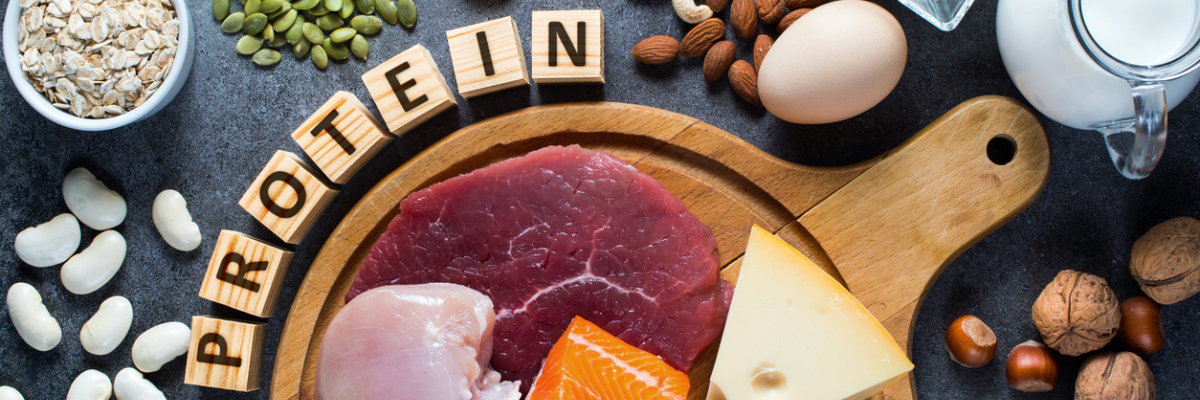
High-protein diets are trending, protein supplement sales are soaring, and you’ll find protein added to everything from breakfast cereals to pastas. In this article we break down what protein is, how much you need, and how to make sure you get enough.
What is Protein?
Proteins are essential to the functioning of every system in your body. Proteins serve as the building blocks for muscles, skin, hormones, and enzymes. Nutrition research shows adequate protein intake supports the repair of muscle breakdown, especially as we age. When you consume enough protein, muscle tissue can heal and grow.
Beyond muscle repair and growth, protein has many benefits. Protein helps stabilize blood glucose levels by slowing the absorption of glucose into the blood stream. This is particularly helpful for maintaining energy levels. Protein contributes to satiety, leaving you full longer compared to meals with primarily carbohydrates or fats. Protein helps your body regulate hormones, aids in digestion, and supports organ function. Including adequate protein in your eating pattern is essential for optimal health.
How Much Protein Do You Need Daily?
The current Recommended Daily Allowance (RDA) for adults 19 years and older is 0.36 grams per pound of body weight. New research recommends increasing the recommended daily intake of protein. See the below chart for reference:
| U.S. Recommended Daily Allowance for Protein (grams per pound of body weight) | New Requirements for Protein (grams per pound of body weight) |
| | |
| | |
Pregnant or lactating women | | |
While the Centers for Disease Control and Prevention (CDC) reports that most adult Americans eat more protein than the recommended amount, an Ohio State University study shows the elderly and pregnant women are not meeting the adjusted requirements.
Individuals with medical conditions should consult with a registered dietitian to tailor protein intake to their needs, as some conditions, like kidney disease, may require adjustments to the standard RDA.
What Are the Main Sources of Protein?
Animal-based proteins such as meats, poultry, fish, eggs, and dairy are quality proteins that contain all essential amino acids. Consider the options below for optimal quality when purchasing animal-based proteins.
Grass-fed and organic meat contain up to 50% more omega-3 fatty acids than grain-fed meats, which contribute to heart health and reduce inflammation.
Organic and free-range poultry are raised without antibiotics and hormones. Organic poultry eat organic feed, reducing exposure to pesticides.
Wild-caught fish is optimal because of lower levels of contaminants compared to farmed fish and higher levels of omega-3 fats.
Organic, pasture-raised eggs come from hens allowed to roam freely outdoors, resulting in higher quality.
Organic dairy products are free from synthetic chemicals, antibiotics and hormones.
Plant-based proteins are found in nuts, seeds, beans, legumes, and vegetables. These foods can fulfill all protein requirements when incorporated into a diverse and balanced eating pattern. For those who are vegetarian or vegan, combining legumes with grains is particularly beneficial.
What Are Some Budget-Friendly Tips for Including More High-Quality Proteins?
Decide which high-quality proteins are most important and allocate your budget accordingly. For example, prioritize wild-caught fish and choose less expensive plant-based proteins for other meals.
Purchase larger quantities, such whole grass-fed chicken, to reduce the cost per serving.
Take advantage of sales and discounts for organic and grass-fed products.
Canned and frozen fish can be affordable while still providing the benefits of wild-caught fish. Choose canned light tuna for lower mercury levels, and consider varieties like salmon, sardines, and mackerel.
Buy local and seasonal products, which may offer better prices on organic and pasture-raised options.
Combine high-quality animal proteins with less expensive plant-based proteins to stretch your budget.

Is it ok to use protein powders?
Animal or plant sources of protein are preferred over powders. Protein powders are unnecessary since most people get enough protein through food. However, protein powders can be a practical option for those who struggle to meet their protein needs with food alone.
Protein powders are made from many different ingredients like whey, casein (from milk), soy, pea, hemp, or rice proteins. Choose a protein powder type that matches your food preferences and restrictions. Look for powders that primarily contain the protein source itself, without added sweeteners, oils, or preservatives.
What are some tips to ensure I am getting enough protein?
Aim for 25 to 40 grams of protein per meal for optimal absorption.
Try protein-rich snacks like yogurt, nuts, or cheese between meals.
Add protein-rich Ingredients like quinoa, beans, or tofu to your recipes to enhance protein content in meals.
What are some ideas for protein-rich snacks?
Almond butter & banana on sprouted grain toast, or plain Greek yogurt with fresh berries and nuts are easy choices for snacks or breakfast. Cottage cheese with chunks of fresh pineapple and chopped mint is another fresh option.
A handful of spiced roasted chickpeas is a great packable snack. Rinse chickpeas and toss with olive oil, cumin, paprika, and a pinch of salt, then roast until crispy.
Thickly sliced rounds of cucumber topped with a smear of cream cheese and a small piece of smoked salmon could be a snack or lunch. Add a fresh dill garnish, for a snack, lunch or appetizer.
Examples of Protein Content: